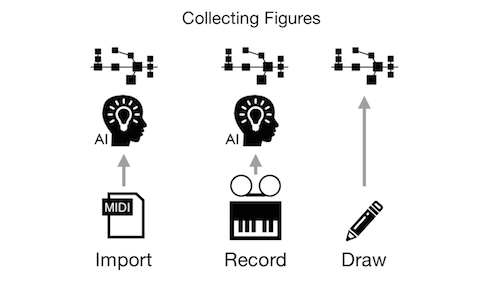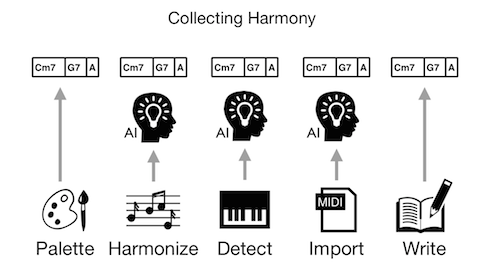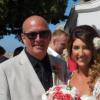
Posted
Since the core formula of Synfire is Figure + Harmony = Music, it implies a core workflow:
1. Collect Figures (Phrases)
2. Collect Harmony (Progressions)
3. Arrange
Just made these diagrams for a Synfire intro presentation:


After working with Synfire night and day for months (yes, I do eat my own dogfood), my main conclusion is, apart from the user interface improvements already in the making, there needs to be more content available to start with out of the box. I reckon that most users, demo users especially, quickly get to the point where they feel there could be more phrases and progressions to experiment with and, for lack of time or other reasons, the effort of collecting these beforehand is slowing them down. Even more so as editing & fixing phrases after import requires some experience to do right.
Progressions
Regarding progressions, I found that saving them as templates (to appear in the menu) is cumbersone and not suited for larger collections. Therefore I simply pull progressions into a library. This way I have all of them at hand on the sidebar of every arrangement.
Thanks to palettes, creating progressions on-the-fly is really easy. I rarely feel the need to build big libraries of them. Maybe I should. Song books are great for learning the ropes. Once you got an idea how a cadence looks on a palette, it can be easily used in all keys.
Phrases (Figures, for the most part)
There are thousands of midi files out there and getting decent phrases from them is not rocket science. Although, to get the best results, some training and background knowledge is very helpful. Even I still have to think hard every now and then, whether to group a segment this way or another way. A few easy-to-follow rules would be great. I'll publish a video on that topic.
Drums are a no-brainer, just copy & paste. Basslines, solos, melodies, all no problem. Some dense piano and guitar phrases are a challenge for pattern recognition. I often edit them before use.
Feedback
How and where do you collect your raw material, phrases and progressions? Which tools do you use most often? Which less?
So., 14.12.2014 - 20:37 Permalink
I try now to use midi kits for inspiration and learning
Example: Looptroniks - Violins Dramatic Series
Listening to the audio examples and try to emulate this in Synfire at least
Play further with this...
Problem with this midi kit unfortanely are the midi files in format 1 ( more work: load first in DAW )( mostly are they in format 0 )
So., 14.12.2014 - 23:15 Permalink
Progressions
I don't tend to collect them; I use new ones each time. However I find the 'Standards' progressions fun to play with and I wish there was some more like that already available.
Phrases
I collect some from MIDI files and put them into libraries, but I'm not very good at it and often I make them too long. I'm also not sure how to correct them, especially the Pattern Recognition ones which can often sound messy. I also still don't really understand why, after dropping a saved phrase into a progression, it is necessary to analyse the take again to get the best results. I thought phrases should fit any harmony.
Also I can't make libraries too big, otherwise they take a lot of memory. I think this issue is Windows only if I remember correctly.
Workflow
For figures, I sometimes import (as above), rarely draw, often record. I usually have an idea in my head for a melody or a riff, so I record it. I also find this to be the best way to get the rhythm that I want. Sometimes, I'll just record the same note to get the correct rhythm, and then move the notes around afterwards.
For harmonies I use Harmonize almost exclusively, from the phrases I have recorded. I usually have a rough idea of the chords, but Harmonize is exceptional for offering suggestions I hadn't thought of and doing this always makes my perceived harmonies a hell of a lot better.
I sometimes use Detect if I'm stuck and want a chord with particular notes in it. I never write chords and I never use the progressions from import.
Finally, I use Palettes rarely for writing progressions. You say it's easy but I do not yet find it as such. Probably because I haven't got round to using Sketches much.
Mo., 15.12.2014 - 00:21 Permalink
Thanks for your feedback.
I also still don't really understand why, after dropping a saved phrase into a progression, it is necessary to analyse the take again to get the best results.
Once the Figure is ok, it works with any harmony. Edits may be necessary immediately after the first pattern recognition (that is, the import or recording), to fix odd segment groupings or symbol types. Sometimes notes are treated as bass where they shouldn't, which is often caused by a wrong lower playing range. Just to name an example.
Mo., 15.12.2014 - 00:43 Permalink
Sometimes notes are treated as bass where they shouldn't, which is often caused by a wrong lower playing range.
Playing ranges is a big issue for me. I work with a lot of piano and I find the default piano range sweet-spot for the mid range to be too high. If left at default, the Pattern Recognition for piano often sounds pretty bad. I find that adjusting the sweet-spot down by only a few semitones usually does the trick. But I can't seem to find the right spot so that everything works fine. I sometimes wonder if it would be better for Synfire to somehow determine the sweet-spot itself from the notes actually played in the MIDI file.
I hope I'm not digressing from the original topic. Perhaps this would be better moved to a separate topic?


